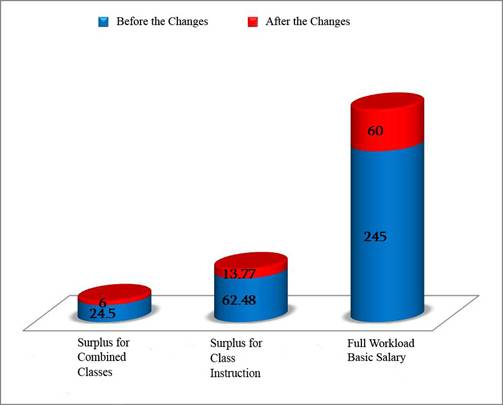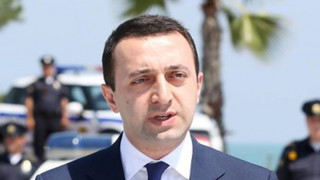On 4 June 2014, the Prime Minister of Georgia, Irakli Gharibashvili, met with representatives of the media. During the press conference the Prime Minister talked about the reforms in the educational system, focusing his attention upon teachers’ wages and the construction and repair of schools. He stated: “Teachers’ wages have been raised and tens of millions of lari have been allocated for the construction and repairs of school buildings.”
FactCheck took interest in the Prime Minister’s statement and verified its accuracy.
In order to request information about teachers’ wages and funds allocated for the construction and repairs of school buildings, we sent an official letter to the Ministry of Education and Science of Georgia. We received the requested information about schools on time; however, the information about wages took one month to arrive.
According to the Ministry of Education and Science of Georgia, the secondary education facilities in Georgia are legal entities of public law. According to the Directive of the Government of Georgia on the Allocation of Normative Financial Resources and the Respective Vouchers for Funding the Secondary Education of a Student, secondary schools are entitled to monthly funding (each secondary school receives a voucher for each student). Within the boundaries of governmental funding, the administration of a secondary school then pays wages to the employed teachers. The calculation of the teachers’ wages is based upon the 21 October 2005 Directive No. 576 of the Minister of Education and Science of Georgia on the Approval of the Instructions about the Conditions and Amount of the Wages of Secondary School Teachers. The Directive regulates the norms and conditions for the calculation of teachers’ wages.
Before we examine the issue of the increased wages, let us look into the mechanisms of the distribution of wages and surpluses for secondary school teachers.
The aforementioned Directive determines that the payments to teachers include the salary and the surpluses as well. Different kinds of surpluses can be distributed.
The calculation of salaries and surpluses for teachers is based upon the following criteria: a) qualification of the teacher, b) pedagogical, scientific or creative activities in the higher, secondary or professional education facilities, c) workload and d) type of work.
The education and qualification of the secondary school teachers has five levels with respective coefficients to each level.
The work experience of a teacher is an additional factor in the calculation of the wages. The experience has three levels with respective coefficients assigned to each level: a) up to five years – 0.2, b) from five to ten years – 0.5 and c) ten years or more – 0.6.
The surpluses to the wages are also calculated based upon the type of work done by the teachers. The workload is also a factor and there are three different types.
The final wages of secondary school teachers are calculated by the multiplication of the basic salaries to the coefficients of the aforementioned criteria. As for the growth of teachers’ wages, the Ministry of Education and Science of Georgia voiced this on 19 February 2013. In terms of the 2013 annual budget, the wages of secondary school teachers were raised by 26%-59%. Namely:
 The 2014 annual budget of Georgia does not include the wage growth for secondary school teachers. However, according to the statement of the Minister of Education and Science of Georgia, Tamar Sanikidze, movement of a teacher to a higher category will have a direct influence upon his/her wage.
It should also be pointed out that the growth of secondary school teacher wages has happened step by step every year. For example, the full workload basic salary of a teacher was GEL 115 in 2005 while it amounted to GEL 220 in 2009. From 1 September 2009, the full workload basic salary increased from GEL 220 to GEL 245. The surplus for a class instructor also rose from GEL 27 to GEL 63.
As for the construction and repairs of school buildings, according to the data received from the Ministry of Education and Science of Georgia, the amounts of money assigned for this process upon a yearly basis was as follows (figures in GEL):
The 2014 annual budget of Georgia does not include the wage growth for secondary school teachers. However, according to the statement of the Minister of Education and Science of Georgia, Tamar Sanikidze, movement of a teacher to a higher category will have a direct influence upon his/her wage.
It should also be pointed out that the growth of secondary school teacher wages has happened step by step every year. For example, the full workload basic salary of a teacher was GEL 115 in 2005 while it amounted to GEL 220 in 2009. From 1 September 2009, the full workload basic salary increased from GEL 220 to GEL 245. The surplus for a class instructor also rose from GEL 27 to GEL 63.
As for the construction and repairs of school buildings, according to the data received from the Ministry of Education and Science of Georgia, the amounts of money assigned for this process upon a yearly basis was as follows (figures in GEL):
According to the Ministry of Education and Science of Georgia, the rehabilitation of secondary education institutions by the Educational and Scientific Infrastructure Development Agency (ESIDA) is a gradual process. The full rehabilitation process of schools may take several years. The statistics of the repaired school buildings from 2009 to 2013 are as follows:
The statistics of the construction of schools from 2009 to 2013 are:
- The full workload basic salary increased from GEL 245 to GEL 305.
- The surplus according to work experience also increased.
- The surplus for combined classes (two or more classes combined) increased from GEL 24.5 to GEL 30.5.
- The surplus for teachers employed in non-Georgian schools teaching Georgian literature, history or geography was also subject to an increase.
- The surplus for the class instructor increased from GEL 62.48 to GEL 76.25.
- For a workload from 19 to 26 hours, the teacher has a surplus of GEL 5 for each additional hour.
- A certified teacher receives a surplus if the workload of the elementary-level teacher is 13 hours a week.
- The certification surplus is also given to the teacher (except elementary-level teachers) if his/her workload is from 15 to 17 hours a week.
 The 2014 annual budget of Georgia does not include the wage growth for secondary school teachers. However, according to the statement of the Minister of Education and Science of Georgia, Tamar Sanikidze, movement of a teacher to a higher category will have a direct influence upon his/her wage.
It should also be pointed out that the growth of secondary school teacher wages has happened step by step every year. For example, the full workload basic salary of a teacher was GEL 115 in 2005 while it amounted to GEL 220 in 2009. From 1 September 2009, the full workload basic salary increased from GEL 220 to GEL 245. The surplus for a class instructor also rose from GEL 27 to GEL 63.
As for the construction and repairs of school buildings, according to the data received from the Ministry of Education and Science of Georgia, the amounts of money assigned for this process upon a yearly basis was as follows (figures in GEL):
The 2014 annual budget of Georgia does not include the wage growth for secondary school teachers. However, according to the statement of the Minister of Education and Science of Georgia, Tamar Sanikidze, movement of a teacher to a higher category will have a direct influence upon his/her wage.
It should also be pointed out that the growth of secondary school teacher wages has happened step by step every year. For example, the full workload basic salary of a teacher was GEL 115 in 2005 while it amounted to GEL 220 in 2009. From 1 September 2009, the full workload basic salary increased from GEL 220 to GEL 245. The surplus for a class instructor also rose from GEL 27 to GEL 63.
As for the construction and repairs of school buildings, according to the data received from the Ministry of Education and Science of Georgia, the amounts of money assigned for this process upon a yearly basis was as follows (figures in GEL):
|
2009 |
2010 |
2011 |
2012 |
2013 |
|
|
24,764 ,430.76 |
14,166,026.47 |
29,011,457.97 |
52,953,280.92 |
39,620,871.21 |
|
2009 |
2010 |
2011 |
2012 |
2013 |
|
364 buildings |
302 buildings |
225 buildings |
535 buildings |
581 buildings |
- 2009 – Construction of one building finished. Two more in progress.
- 2010 – Construction of three buildings finished.
- 2011 – Construction of five buildings finished.
- 2012 – Construction of nine buildings finished.
- 2013 – Construction of one building finished. Eight more started.








